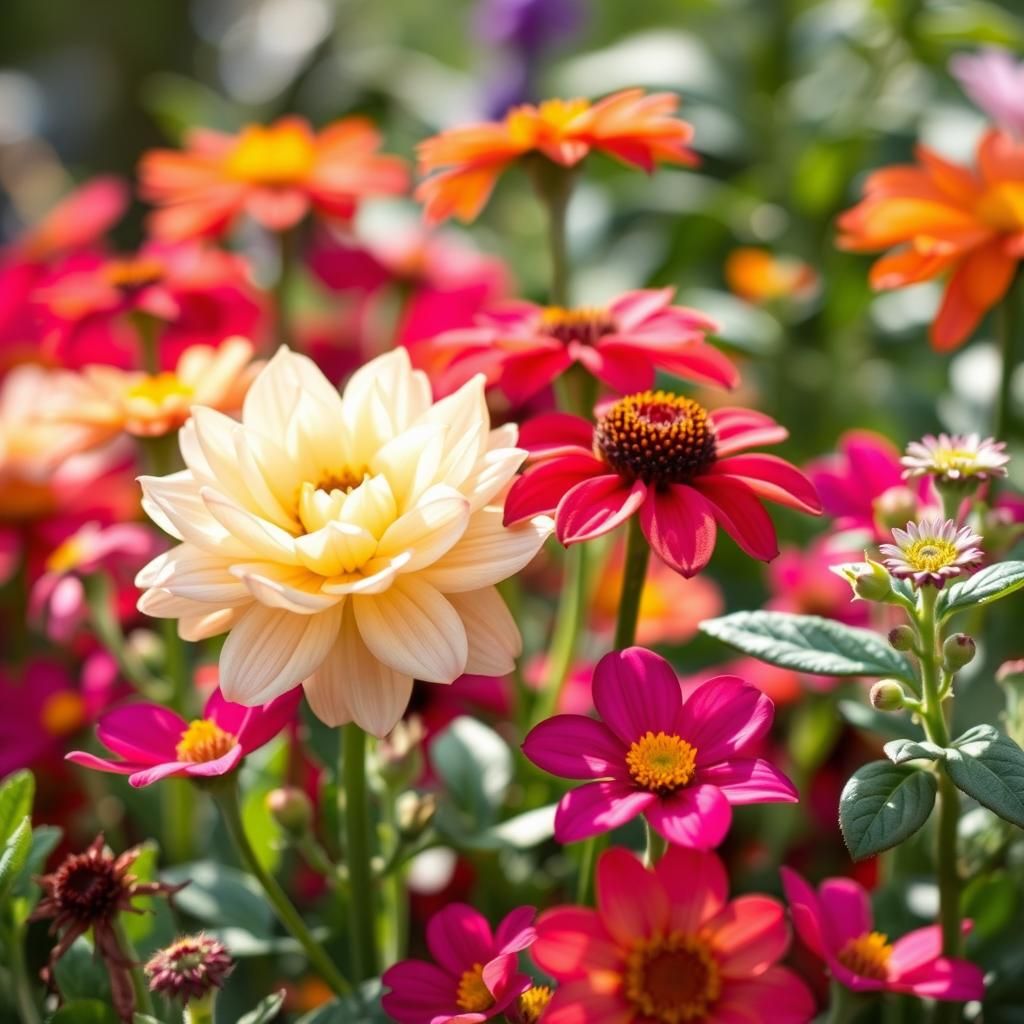Ultimate Guide: What Plants to Plant in Summer for a Thriving Garden

As summer approaches, many gardening enthusiasts eagerly prepare for the vibrant growing season ahead. Choosing the right plants to cultivate during this time is crucial for creating a flourishing garden that thrives under the sun's warm embrace. This ultimate guide will explore a variety of summer-friendly plants, detailing their unique characteristics, care requirements, and how they can enhance your outdoor space. Whether you're a seasoned gardener or a novice, understanding the ideal selections for summer planting can lead to stunning blooms, bountiful harvests, and a lush environment that attracts beneficial wildlife. Let's dive into the best choices for a thriving summer garden!
What Plants to Plant in Summer
During the summer, it's essential to focus on plants that thrive in the warm weather and can withstand the heat. Consider opting for annuals like zinnias, marigolds, and petunias, which not only add vibrant colors to your garden but also continue to bloom throughout the season. Additionally, vegetables such as tomatoes, peppers, and cucumbers are excellent choices as they benefit from the longer days and warmer soil temperatures, yielding a bountiful harvest. Herbs like basil and oregano also flourish during this time, enhancing your culinary experiences while being easy to care for. Always ensure that your plants are well-watered and receive plenty of sunlight for optimal growth.
Annual Flowers for Summer
Annual flowers are a fantastic choice for summer gardens as they bloom continuously throughout the season. Zinnias, known for their vibrant colors, attract butterflies and are easy to grow from seeds. Marigolds, with their bright yellow and orange hues, are not only visually stunning but also act as natural pest repellents. Petunias offer a wide array of colors and patterns, making them ideal for hanging baskets and borders. These plants thrive in full sun and contribute significantly to the overall beauty of your summer garden.
Summer Vegetable Varieties
When selecting vegetables to plant during the summer, consider heat-loving options such as tomatoes, peppers, and squash. Tomatoes require consistent moisture and plenty of sunlight, making summer the perfect season for them to reach their full potential. Peppers, including bell and jalapeño varieties, benefit from the heat, producing abundant yields. Summer squash, such as zucchini, grows quickly and can be harvested multiple times, making it a rewarding plant for any gardener. Proper spacing and regular watering will ensure successful growth throughout the summer months.
Herbs to Grow in Summer
Growing herbs in the summer is not only practical but also enjoyable for those who love cooking. Basil is one of the most popular summer herbs, thriving in warm temperatures and making a perfect addition to salads and pasta dishes. Oregano flourishes in sunny spots and is easy to maintain, perfect for seasoning various meals. Other herbs like cilantro and dill can also be planted, providing fresh flavors throughout the cooking season. Regular harvesting encourages healthy, bushy growth and enhances the flavor profiles of your culinary creations.
Benefits of Native Plants in Summer
Native plants are a sustainable choice for summer gardening as they are naturally adapted to the local climate and soil conditions. These plants typically require less water and fewer chemical inputs, making them more environmentally friendly. Varieties such as coneflowers, black-eyed Susans, and lavender thrive in summer while attracting local wildlife, like bees and butterflies, that play critical roles in pollination. By choosing native plants, gardeners can create vibrant landscapes that support local ecosystems and require minimal maintenance, all while flourishing in the summer heat.
Tips for Maintaining Summer Gardens
Maintaining a summer garden requires specific strategies to address the challenges posed by heat and drought. Regular watering is crucial, preferably in the early morning to reduce evaporation. Adding mulch helps retain soil moisture and keeps roots cool. Furthermore, pruning and deadheading flowers encourage continuous blooming and overall plant health. It's also vital to monitor for pests and diseases, using organic methods when possible to minimize damage to your plants. With attentive care, your summer garden can thrive and produce beautiful blooms or a bountiful harvest.
| Plant Name | Type | Benefits |
|---|---|---|
| Zinnia | Annual Flower | Attracts butterflies, vibrant colors |
| Tomato | Vegetable | High yield, versatile for cooking |
| Basil | Herb | Enhances culinary dishes, easy to grow |
| Lavender | Native Plant | Attracts pollinators, aromatic |
| Marigold | Annual Flower | Pest repellent, vibrant colors |
What is the best plant to plant in summer?

The best plant to plant in summer varies depending on the climate and the specific needs of the gardener. However, one of the top contenders is the tomato, as it thrives in warm weather and can yield bountiful harvests.
Why Tomatoes are Ideal for Summer Planting
Tomatoes are often considered one of the best plants to grow during the summer due to their preference for heat and sunlight. They require a consistent warm temperature to grow, making them perfect for summer months. Furthermore, tomatoes are quite versatile, allowing gardeners to enjoy them in various dishes.
- High yield and productivity.
- Wide range of varieties to choose from.
- Rich in nutrients and flavors.
Other Great Summer Plants to Consider
While tomatoes are a popular choice, there are many other plants that perform well in summer conditions. These plants not only thrive in heat but also add beauty and functionality to your garden.
- Peppers - Bell peppers and hot peppers enjoy similar warmth and provide a colorful addition to meals.
- Basil - This aromatic herb grows rapidly in warm conditions and pairs exceptionally well with tomatoes.
- Sunflowers - These vibrant flowers can withstand summer heat and bring cheer to any garden.
Essential Care Tips for Summer Plants
To ensure the success of summer plants, adequate care is essential. This includes paying attention to watering, sunlight, and pest management, which can all significantly affect plant growth and health.
- Water thoroughly, especially during dry spells, to maintain proper soil moisture.
- Ensure plants receive full sun, which is typically about 6-8 hours of direct light daily.
- Utilize organic pest control methods to protect plants without harsh chemicals.
Companion Planting for Summer Growth
Companion planting is a gardening technique that involves growing different plants together for mutual benefit. This practice can enhance growth and deter pests, making it a useful strategy, especially in summer.
See also:
- Basil with tomatoes - Enhances flavor and can repel certain harmful insects.
- Marigolds with vegetables - These flowers can deter nematodes and other pests.
- Beans with corn - Beans fix nitrogen in the soil, benefiting corn as it grows.
Climate Considerations for Summer Planting
Understanding your local climate is crucial when selecting plants for summer. Different regions will have varying temperature ranges, humidity levels, and rainfall patterns, all of which can impact plant success.
- Choose heat-tolerant varieties if you live in hotter regions.
- Consider moisture-retaining techniques, such as mulch, in arid areas.
- Research your USDA Hardiness Zone to select appropriate plants for your climate.
Which plant is best for summer season?

The best plants for the summer season are typically those that thrive in warm temperatures, require moderate to low watering, and can withstand direct sunlight. Some of the top choices include succulents, annual flowers, and herbs. Here are some detailed options:
1. Succulents
Succulents are known for their ability to store water in their leaves and stems, making them ideal for the hot summer months. They require very little care and can adapt well to dry environments. Popular varieties include Aloe Vera, Echeveria, and Sedum.
- Low water requirement
- Thrives in direct sunlight
- Variety of forms and colors
2. Annual Flowers
Annual flowers bloom beautifully during the summer, providing vibrant color and lively displays. Some favorites include Petunias, Marigolds, and Zinnias. They can handle the heat well and can create stunning landscapes.
- Provide instant color to gardens
- Continuous blooming throughout the season
- Easy to grow from seeds or transplants
3. Herbs
Herbs such as Basil, Thyme, and Mint not only add flavor to dishes but also flourish during the warm months. They often require full sun and well-drained soil, making them perfect for summer gardening.
- Enhance culinary dishes
- Can be grown in containers or gardens
- Some varieties deter pests naturally
4. Perennials
Though they take longer to establish, perennial plants like Lavender, Coneflower, and Daylilies come back year after year and can handle summer heat with minimal fuss. They bring lasting beauty and can attract beneficial pollinators.
- Long-term investment in your garden
- Diverse colors and textures
- Attracts bees and butterflies
5. Vegetables
Several vegetable plants like Tomatoes, Peppers, and Zucchini thrive in summer heat. These plants grow quickly and can yield a bountiful harvest for home gardeners looking to utilize their gardens for edible produce.
- High yield in favorable weather
- Can be used to create fresh summer meals
- Offers the satisfaction of growing your own food
Is it okay to plant plants in summer?

Yes, it is possible to plant plants in summer, but there are specific considerations and techniques that should be followed to ensure the success of planting during the hottest months of the year. Summer planting can be advantageous due to longer daylight hours and warmer soil temperatures, which can help plants establish themselves quickly. However, the challenges posed by heat and potential drought must be taken into account.
Watering Practices
When planting in summer, it is essential to focus on effective watering practices. Newly planted plants often require more water to help them adapt to their new environment and continue growing.
- Morning Watering: Water your plants in the morning to reduce evaporation and allow them to absorb moisture throughout the day.
- Regular Checking: Monitor the moisture levels in the soil frequently, especially in hot weather, to prevent plants from drying out.
- Deep Watering: Water deeply and less frequently to encourage deep root growth, which helps plants survive heat stress.
Choosing the Right Plants
Selecting appropriate plants is crucial for successful summer planting. Some plants thrive in warmer temperatures, while others may struggle.
- Heat-Tolerant Varieties: Opt for plants that are known for their resilience to heat, such as succulents, zinnias, and certain herbs.
- Native Plants: Consider using native plants that are adapted to your local climate and require less care.
- Warm-Season Vegetables: Many vegetables, like tomatoes and peppers, can be planted in late spring or early summer to mature in warm weather.
Soil Preparation
Proper soil preparation is vital when planting in summer to ensure your plants have the best possible start.
See also:
- Soil Testing: Conduct a soil test to determine nutrient levels and pH, making necessary amendments as needed.
- Mulching: Apply a layer of mulch around your plants to help retain moisture and regulate soil temperature.
- Organic Matter: Incorporate organic matter, such as compost, into the soil to improve its structure and drainage.
Pest Management
Summer can be a peak time for pests that may threaten young plants. It’s vital to have a pest management strategy in place.
- Regular Inspection: Examine your plants regularly for signs of pest damage and take action as necessary.
- Natural Predators: Encourage beneficial insects like ladybugs and lacewings that help control pest populations.
- Organic Solutions: Use organic pesticides and repellents as a preventive measure to minimize pest issues.
Climate Considerations
Understanding your local climate conditions is essential when planning to plant in summer. Different regions may present unique challenges.
- Heat Waves: Be aware of potential heat waves and have a plan in place for protecting your plants during extreme temperatures.
- Humidity Levels: Consider humidity levels in your area as they can affect plant health and water requirements.
- Seasonal Changes: Monitor seasonal changes so you can plant at the right time for optimal growth throughout the summer months.
What plants do well in heat and full sun?
:max_bytes(150000):strip_icc()/growing-portulaca-1315707-11-d8d849aca1e64fea8f3ec236f1c31b14.jpg)
When it comes to gardening in hot and sunny conditions, selecting the right plants is crucial. Many plants thrive in full sun and can withstand the heat, making them ideal choices for such environments. Below is a selection of plants that perform well in these conditions.
Succulents
Succulents are drought-resistant plants that store water in their leaves, making them perfect for hot climates. They require minimal watering and thrive in sunny spots. Some popular types include:
- Echeveria - Forms beautiful rosettes and comes in various colors.
- Aloe Vera - Known for its medicinal properties and striking appearance.
- Agave - A bold architectural plant that can grow quite large.
Perennials
Many perennial plants are well-adapted to heat and full sun, providing beautiful blooms season after season. They typically require less maintenance once established. Among them are:
- Black-eyed Susan - Bright yellow flowers that attract pollinators.
- Lavender - Fragrant and drought-tolerant, perfect for sunny gardens.
- Coneflower - Hardy and known for its vibrant purple petals.
Ornamental Grasses
Ornamental grasses add movement and texture to gardens, and many varieties thrive in hot, sunny conditions. They are generally low-maintenance and provide year-round interest. Popular choices include:
- Feather Reed Grass - Tall and elegant, great for adding height.
- Blue Fescue - Features a lovely blue tint and a compact form.
- Pampas Grass - Known for its dramatic plumes and striking presence.
Cacti
Cacti are synonymous with hot, arid environments and are perfect for gardens that receive a lot of sunlight. They require minimal watering and are very resilient. Common varieties include:
- Barrel Cactus - Round and easy to maintain, ideal for focal points.
- Indigo Spined Cactus - Unique color and striking thorns.
- Opuntia (Prickly Pear) - Produces edible fruit and vibrant flowers.
Vegetables
Certain vegetables also thrive in warm, sunny gardens, allowing for homegrown produce even in hot weather. These plants generally require full sun for at least 6-8 hours a day:
- Tomatoes - A favorite for many gardeners, they flourish with ample sunlight.
- Peppers - Enjoy hot weather and full sun, producing spicy fruits.
- Eggplants - Thrive in heat and can yield rich, delicious harvests.
Questions from Our Readers
What are the best vegetables to plant in summer?
The best vegetables to plant in summer include tomatoes, peppers, cucumbers, and beans. These plants thrive in warm temperatures and can produce a bountiful harvest if given proper sunlight and watering.
Can I plant flowers in summer?
Yes, summer is an excellent time to plant various flowers such as marigolds, zinnias, and sunflowers. These flowers can add vibrant color to your garden and are well-adapted to hot weather conditions.
What herbs are suitable for summer planting?
Suitable herbs for summer planting include basil, cilantro, and oregano. These herbs flourish in the summer heat and can enhance your dishes with their flavorful aromas.
How can I prepare my garden for summer planting?
To prepare your garden for summer planting, ensure the soil is well-drained and rich in nutrients. Adding compost and mulch can help retain moisture and provide essential nutrients for your summer crops.
See also:

If you want to read more articles like Ultimate Guide: What Plants to Plant in Summer for a Thriving Garden, we recommend you check out our Gardeners category.
Leave a Reply
Related Articles